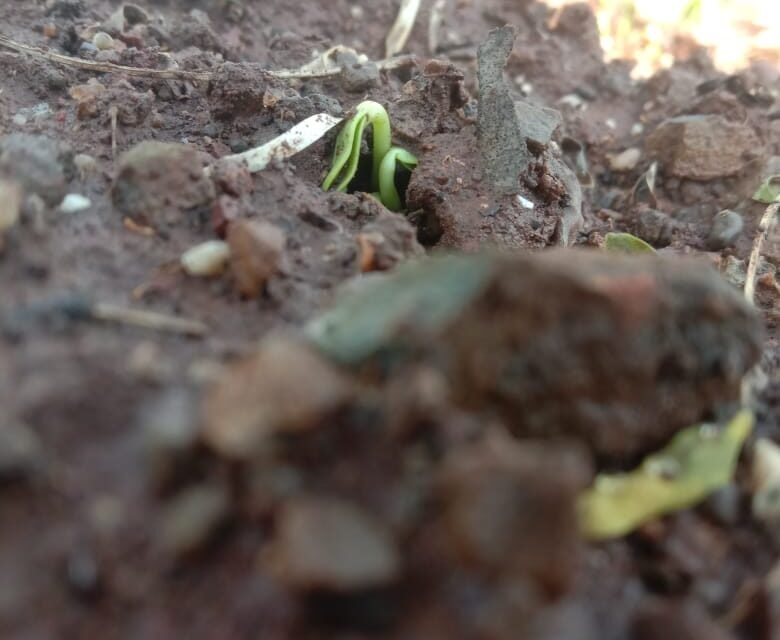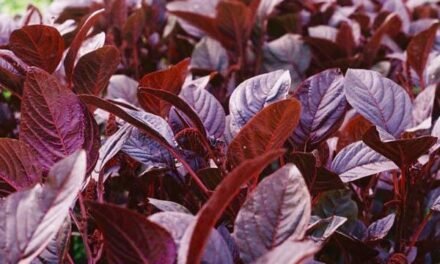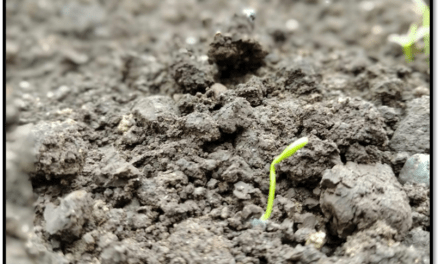Introduction:
The purpose of this case study is to, day by day the soil is become very nonfertile because of the very higher use of the chemical fertilizers and pesticides. We are going to use Jivamruta and culture as organic fertilizer without using any types of chemical fertilizers. If we use this organic Jivamruta and culture soil become less nonfertile and also, we conserved the soil very well. This Jivamruta and culture is cost effective organic fertilizers so farmers can made these fertilizers on their home.
Objectives:
- To make Jivamruta.
- To observed growth of fenugreek plants by using Jivamruta and culture.
- To observed the effect of soil by using Jivamruta and culture to check the parameters like (Nitrogen, Phosphorus, Potassium, pH, EC And organic carbon).
Need of project:
In todays era, farmers are using chemical fertilizers in agricultural on large scale. Due to excessive use of chemicals, their land is become very non- fertile, and production of crops is also decreasing. So we are going to use Jivamruta and culture both of these are organic fertilizers. Without using of any chemical fertilizer we are going to see the effect of plants and soil by using these two organic fertilizers. farmers who spend lots of money on fertilizers and pesticides can save their money and use this organic fertilizers for plants.
Flow chart:
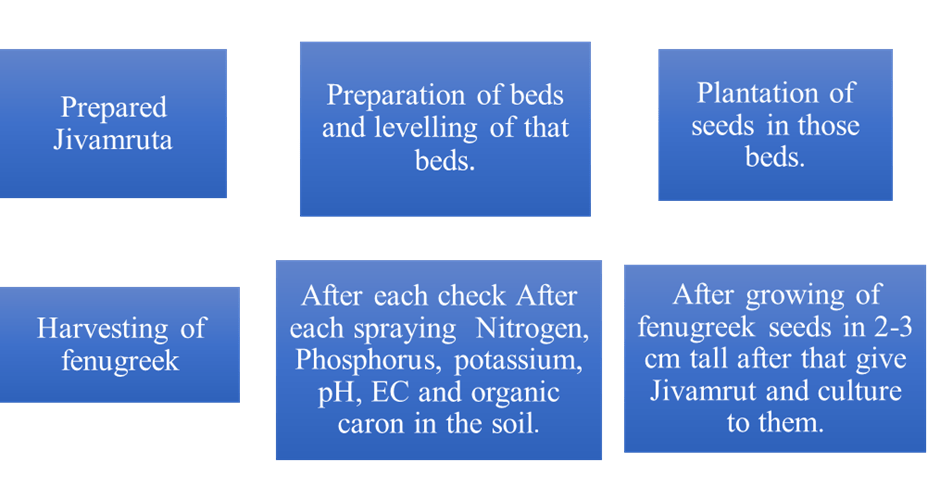
17/11/2022 To 23/11/2022
Procedure:
Firstly, to make Jivamrut for the fenugreek plant. Jivamrut is the traditional Indian bio pesticide and organic manure that is prepared by the unique technique of fermentation of the combined mixture of cow dung, cow urine, jaggery, pulses flour, soil and water. Jivamruta is 100% organic have no harmful effect on soil health.
How to prepare to jeevamrut?
We have made 50 liters of jeevamrut and this is the material given below.
To prepare this organic manure you will need:
| Sr. No | Ingredients | Quantity |
| 1 | Water | 50 liters |
| 2 | Cow dung | 5 kg |
| 3 | Cow urine | 5 liters |
| 4 | Pulse flour (Beasan) | ½ kg |
| 5 | Jaggery | ½ kg |
| 6 | Soil | ½ kg (Handful) |
Procedure to make Jivamruta:
- Mix cow urine, cow dung pulses flour jaggery (dissolved in 10 liters water) and handful of soil in separate container and mix this mixture.
- We take barrel of capacity 50 lit, fill water and prepared mixture of cow dung, cow urine, pulses flour, jaggery and soil in the barrel.
- With the help of wooden stick stir the mixture in the taken barrel clockwise and anticlockwise direction. Repeating this process two time in day i.e. first stir in the morning and second in the evening for 7 days.
- After 7 days this organic manure become ready to be used.
Content present in Jivamruta:
| Sr. No | Minerals | Content of minerals (%) |
| 1 | Nitrogen | 1.40% |
| 2 | Phosphorus | 0.104% |
| 3 | Potassium | 0.084% |
| 4 | Manganese | 4.6% |
| 5 | Copper | 51% |
24/10/2022 To 30/10/2022
Bed preparation:
If we want to use Jivamrut and culture for fenugreek plants, first thing we need to do is to prepare the beds where we want to plant the trees.
Before the preparation of bed cleaned the area, after that measured the area to prepare the beds.
Length= 1m
Breadth = 1m
Area of bed: l*b
=1m*1m
=2 m. sq.

31/10/2022 To 6/11/2022
Plantation of seeds :
We are plantated fenugreek seeds , planted each rows in 9 seeds and in the total there are 90 seeds plantated in Jivamruta and culture bed.

7/11/2022 To 13/11/2022
| Sr. No | Date | Jivamruta bed ( quantity of water / day) | Compost bed ( quantity of water / day) |
| 1 | 1/11/2022 | 7 liters | 7 liters |
| 2 | 2/11/2022 | 8 liters | 8liters |
| 3 | 3/11/2022 | 10 liters | 10 liters |
| 4 | 4/11/2022 | – | – |
| 5 | 5/11/2022 | 10 liters | 10 liters |
| 6 | 6/11/2022 | 9 liters | 9 liters |
| 7 | 7/11/2022 | 7 liters | 7 liters |
| 8 | 8/11/2022 | 7 liters | 7 liters |
| 9 | 9/11/2022 | 7 liters | 7 liters |
| 10 | 10/11/2022 | 6 liters ( 1 liter Jivamruta) | 6 liters (1 liter culture ) |
| 11 | 11/11/2022 | 7 liters | 7 liters |
| 12 | 12/11/2022 | 7 liters | 7 liters |
| 13 | 13/11/2022 | – | – |
| 14 | 14/11/2022 | 6 liters (1 liter Jivamruta) | 6 liters ( 1 liter culture) |
| 15 | 15/11/2022 | 7 liters | 7 liters |
| 16 | 16/11/2022 | 6 liter ( 1 liter Jivamruta) | 6 liter (1 liter culture ) |
| 17 | 17/11/2022 | 7 liters | 7 liters |
| 18 | 18/11/2022 | 6 liter (1 liter Jivamruta) | 6 liter ( 1 liter culture ) |
| 19 | 19/11/2022 | 8 liters | 8 liters |
| 20 | 20/11/2022 | – | – |
| 21 | 21/11/2022 | 7 liters | 7 liters |
| 22 | 22/11/2022 | 6 liters ( 1 lit Jivamruta) | 6 liters (1 liter culture) |
| 23 | 23/11/2022 | 7 liters | 7 liters |
| 24 | 24/11/2022 | 7 liters | 7 liters |
| 25 | 25/11/2022 | 6 liters ( 1 lit Jivamruta) | 6 liters ( 1 lit Jivamruta) |
| 26 | 26/11/2022 | 7 liters | 7 liters |
Testing of soil:
we do testing of soil because of we check that if we apply Jivamruta and culture in that soil , then we checked the Nitrogen phosphorus , potassium can change if apply both these organic fertilizers.
we check the soil testing after three days of applying Jivamruta and culture.
Testing of soil before applying Jivamruta and culture.
| Sr. NO | Parameters | Result |
| 1 | Nitrogen | 0.014 kg/ m sq |
| 2 | Phosphorus | 0.0035 kg/ m sq |
| 3 | Potassium | 0.03 kg/ m sq |
| 4 | pH | 7.6 |
| 5 | EC | 30 |
| 6 | Organic Carbon | 1 % |
After growing of fenugreek we apply Jivamruta and culture for fenugreek plants. we give 7 liters water to plants in that 7 liters of water take 6 liters of water in a bucket and add into 1 liter Jivamruta and spray to plants. same as a culture plot.

1st spraying of Jivamruta and culture on fenugreek plant .


after spraying Jivamruta and culture of plants. ( 1st spray)


After applying Jivamruta and culture the height of plants is increased by 2.5 cm in Jivamruta plot and 2 cm in culture.
14/11/2022 To 20/11/2022
1st spray:
Testing of soil after 3 days applying Jivamruta and culture.
| Sr.No | Parameters | Jivamruta | Culture |
| 1 | Nitrogen | 0.014 kg/ m sq | 0.014 kg/ m sq |
| 2 | Phosphorous | 0.0035 kg/ m sq | 0.0035 kg/ m sq |
| 3 | Potassium | 0.03 | 0.03 |
| 4 | pH | 8.1 | 7.7 |
| 5 | EC | 100 | 81 |
| 6 | Organic carbon | 1 % | 1 % |
After applying both Jivamruta pH is 8.1 and culture pH is 7.7 of the soil was increased. EC have also increased in applied both plots in Jivamruta plot EC is 100 and in Culture plot EC is 81.

2 nd spray:
| Sr.No | Parameters | Jivamruta | Culture |
| 1 | Nitrogen | 0.014 kg/m sq | 0.014 kg/m sq |
| 2 | Phosphorous | 0.0014 kg/ m sq | 0.0035 kg/ m sq |
| 3 | Potassium | 0.02 kg/ m sq | 0.025 – 0.03 kg/ m sq |
| 4 | pH | 5.5 | 6.7 |
| 5 | EC | 119 | 54 |
| 6 | Organic carbon | 1% | 1% |
After 2nd spray in Jivamruta plot phosphorus was change. phosphorus is 0.0035 kg/ m sq i.e. very high. potassium is also change in both Jivamruta and culture plot in Jivamruta 0.02kg/ m sq and culture 0.025-0.03kg/ m sq. pH is change in Jivamruta plot and pH is slightly acidic i.e. 5.5. Also pH is decreased in culture plot and pH is very slightly acidic i.e. 6.7. EC is increased in culture plot i.e. 119 and in culture plot EC is decreased 54.Organic carbon in both plots is same.


after 2nd spray the height of plants in Jivamruta plants is 3.5 cm and culture plot is 2.9 cm.
3rd spraying of Jivamruta and culture :
| Sr.No | Parameters | Jivamruta | Culture |
| 1 | Nitrogen | 0.014kg/m sq | 0.038 kg/m sq |
| 2 | Phosphorous | 0.0028 kg/m sq | 0.0035 kg/m sq |
| 3 | Potassium | 0.03 kg/m sq | 0.025-0.03 kg/m sq |
| 4 | pH | 8.5 | 8.3 |
| 5 | EC | 41 | 35 |
| 6 | Organic carbon | 1 % | 1 % |
After 3rd spray Nitrogen is change is culture plot , i.e. 0.038 kg/m sq ( High), phosphorous is also change Jivamruta plot , i. e is 0.00228 kg/m sq ( medium high), potassium is change in both plots in Jivamruta 0.03 kg/m sq ( Very high), in culture plot 0.025-0.03 kg/m sq ( High) . pH is change in both plots in Jivamruta plot pH is 8.5 ( medium high alkaline) , in culture plot pH is 8.3 ( Medium alkaline ) , EC is also change in Jivamruta i.e. 41 and culture plot EC is 35. Jivamruta plot organic carbon is 1% ( High ) in culture plot Organic carbon is 1 % ( high )


after 3rd spraying the average height of plants in Jivamruta plot is 4.7 cm and culture plot is 3.4 cm.
4th spray:
Sr. No | Parameters | Jivamruta | Culture |
| 1 | Nitrogen | 0.014 kg/ m sq | 0.014 kg/ m sq |
| 2 | Phosphorous | 0.028 kg/ m sq | 0.035 kg/ m sq |
| 3 | Potassium | 0.03 kg/m sq | 0.025-0.03 kg/ m sq |
| 4 | pH | 8.2 | 8.3 |
| 5 | EC | 127 | 135 |
| 6 | Organic carbon | 1 % | 1 % |
After 4th spraying nitrogen is change in culture plot 0.014 kg/ m sq, pH is change in Jivamruta plot i.e. 8.2, EC is increased in both plots in Jivamruta plot EC is 127 and in culture plot is 135.
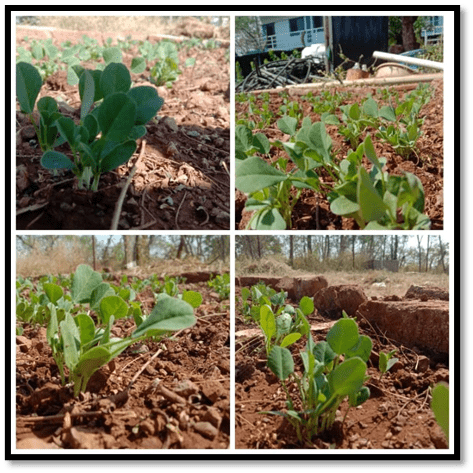
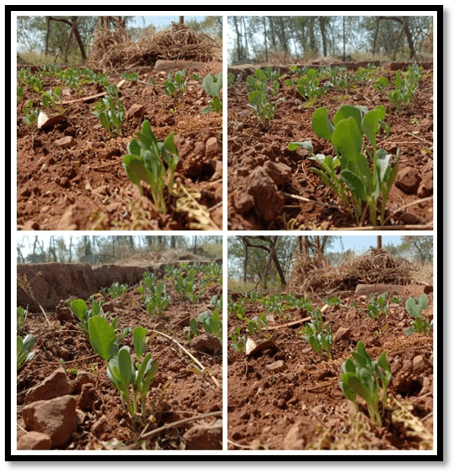
After 4th week the height of plants in Jivamruta plot 7.8 cm and the height of plants in culture plot is 6.7 cm.
5th spray:
| Sr. No | Parameters | Jivamruta | Culture |
| 1 | Nitrogen | 0.014 kg/ m sq | 0.014 kg/ m sq |
| 2 | Phosphorous | 0.028 kg/ m sq | 0.0028 kg/ m sq |
| 3 | Potassium | 0.03 kg/m sq | 0.025-0.03 kg/ m sq |
| 4 | pH | 9.2 | 8.7 |
| 5 | EC | 268 | 478 |
| 6 | Organic carbon | 1 % | 1 % |
After 5 th spray nitrogen is did not change in both plots. Phosphorus is change in culture plot i.e. 0.0028 kg/m sq. PH in both plot is change, in Jivamruta plot pH is 9.2 i.e. highly alkaline in culture plot is 8.7 i.e. Medium high alkaline.
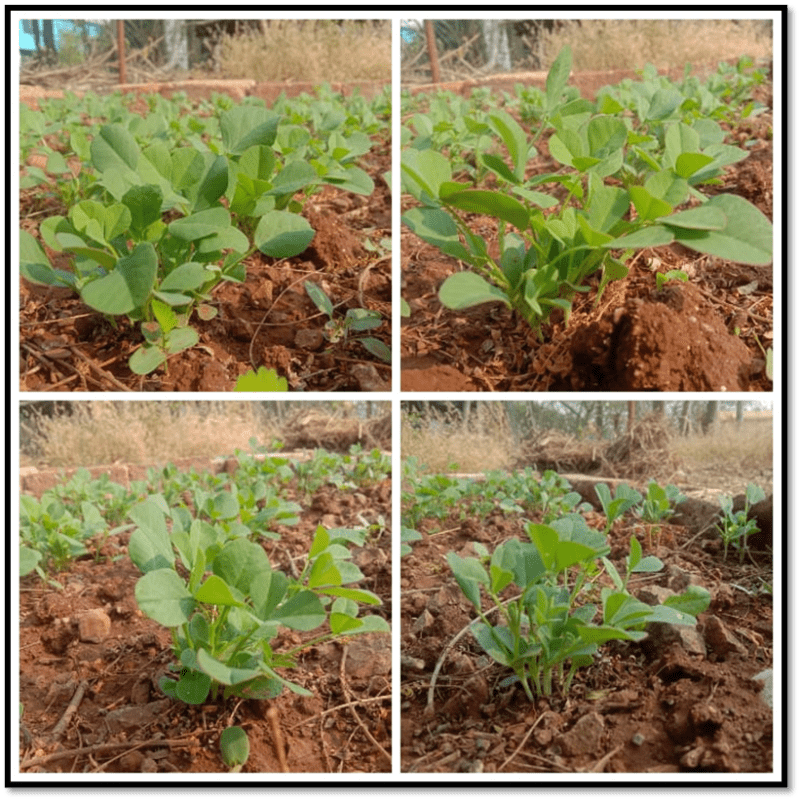
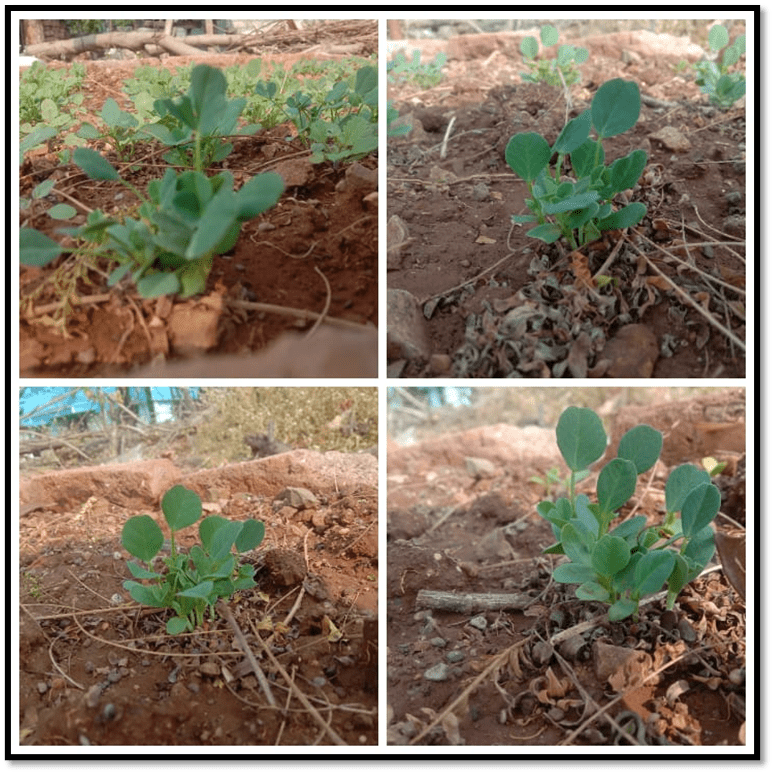
Average height of plants in Jivamruta plot after 5th spraying is 10.2 cm and in culture plot average height of plants is 7.8 cm.

Conclusion:
we applied Jivamruta and culture in the plants at 5 times. in that 5 times spraying observations we seen the following results.
- After each spraying of Jivamruta and culture we seen the pH And electric conductivity of soil is increased and decreased. this first thing we noticed in working.
- Growth of plants is very fast in Jivamruta plot better than culture plot. this 2nd thing noticed.
- In the second plot we apply culture to plants the is not grow fast and height of plants is very less as compared to Jivamruta plot plants. and colors of leaves in culture plot plants is faint in comparatively Jivamruta plot.
- fenugreek is not ready for harvesting because is this winter season and this season plants do not grown fast.

